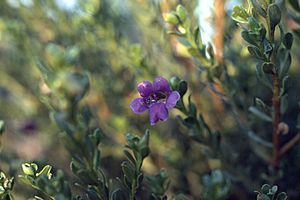Desert foxglove facts for kids
Quick facts for kids Desert foxglove |
|
|---|---|
 |
|
| Scientific classification | |
| Genus: |
Eremophila (plant)
|
| Species: |
platythamnos
|
The Desert Foxglove (scientific name: Eremophila platythamnos) is a beautiful flowering plant found only in Australia. It belongs to the figwort family, which is called Scrophulariaceae. This plant is a straight-growing bush with short, wide leaves. Its flowers can be purple, mauve, blue, or pink.
Contents
What it Looks Like
The Desert Foxglove is a bush that grows upright, usually reaching between 0.3 and 1.5 metres (about 1 to 5 feet) tall. Its branches can sometimes be a bit hairy. They are often sticky and shiny because of a natural substance called resin, which is like a sticky sap.
The leaves grow one after another along the branches. They can be shaped like a spear, an egg, or even almost round. They are usually between 5 and 20 millimetres (about 0.2 to 0.8 inches) long and 2 to 11 millimetres (about 0.08 to 0.4 inches) wide. Depending on the type of Desert Foxglove, the leaves can be hairy or completely smooth (which is called glabrous). They are often sticky, just like the branches, because of the resin.
The flowers usually grow alone or in pairs where the leaves meet the stem. Each flower sits on a small stalk about 4 to 8 millimetres (0.16 to 0.3 inches) long. There are 5 overlapping, pink to purple leaf-like parts called sepals at the base of the flower. These sepals are about 4 to 8.5 millimetres long. After the flower blooms, these sepals grow larger, up to 6 to 14 millimetres long.
The colourful parts of the flower, called petals, are joined together at the bottom to form a tube. This tube is about 14 to 20 millimetres (0.55 to 0.8 inches) long. The outside of the petal tube can be purple, mauve, blue, or pink, while the inside is white. The outside is hairy, but the tips of the petals are smooth. The inside of the tube is full of long, soft hairs. Inside the petal tube, there are 4 stamens (the parts that produce pollen) that are completely hidden.
Desert Foxglove plants bloom between April and November. After the flowers, small, oblong-shaped fruits appear. These fruits are about 5.3 to 6.5 millimetres (0.2 to 0.25 inches) long and have a hairy, papery covering.
How it Got its Name
The Desert Foxglove was first officially described by a scientist named Ludwig Diels in 1905. The plant's scientific name, platythamnos, comes from two Ancient Greek words. Platús means "flat," "broad," or "wide." Thámnos means "bush" or "shrub." So, the name basically means "broad bush."
There are three slightly different types, or subspecies, of Eremophila platythamnos:
- Eremophila platythamnos subspecies platythamnos: This type has smooth (glabrous) branches and leaves.
- Eremophila platythamnos subspecies exotrachys: This type has hairy branches and leaves. Its sepals are different sizes, with the two inner ones being the longest.
- Eremophila platythamnos subspecies villosa: This type also has hairy branches and leaves, but all 5 of its sepals are about the same size.
Where it Grows
The subspecies platythamnos is found in Western Australia, in areas between Wiluna and Rawlinna. It grows in different natural regions like the Coolgardie, Gascoyne, Great Victoria Desert, Little Sandy Desert, Murchison, and Nullarbor. It also grows in the Nullarbor region of South Australia. You can usually find it growing on and between sand dunes.
The subspecies exotrachys grows in similar sandy places. It is found from east of Wiluna, extending into desert areas of South Australia and the southwestern part of the Northern Territory.
The subspecies villosa is only found in South Australia. It grows on sandhills between Lake Gairdner and Lake Everard.
How it is Protected
The types of E. platythamnos found in Western Australia are considered "not threatened" by the Western Australian Government's Department of Parks and Wildlife. This means they are not currently at risk of disappearing.
Growing it in Gardens
All the different forms of the Desert Foxglove have potential for growing in gardens. The ones with colourful sepals are especially pretty because they stand out against the dark green leaves.
Sometimes, bees can cause problems for this plant, similar to how they affect another plant called E. abietina. You can grow new Desert Foxglove plants from cuttings (small pieces of the plant). It likes soil that drains water well, just like the deep sand it grows in naturally. It only needs water occasionally during very long dry periods. Once the plants are grown, they can usually handle frost.

